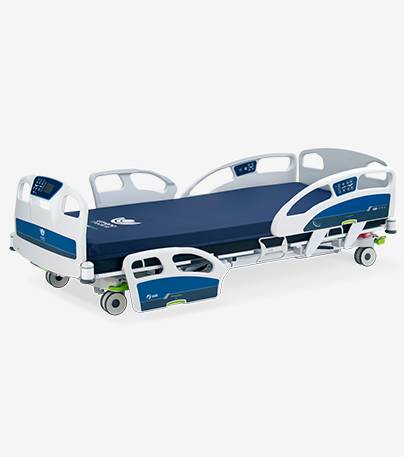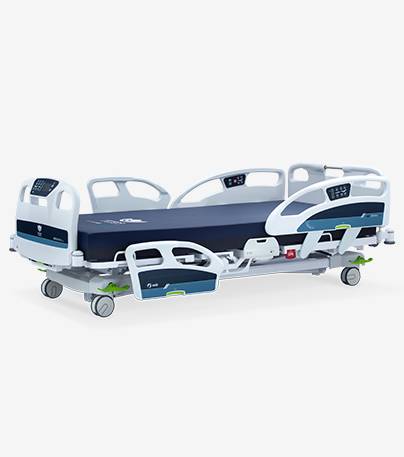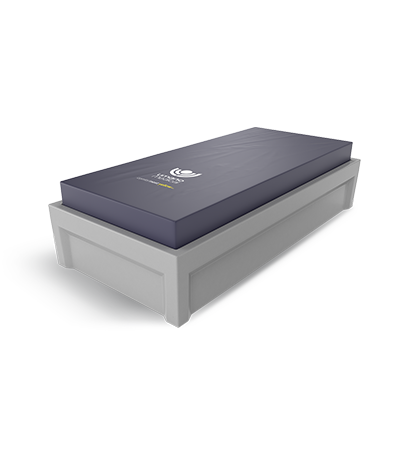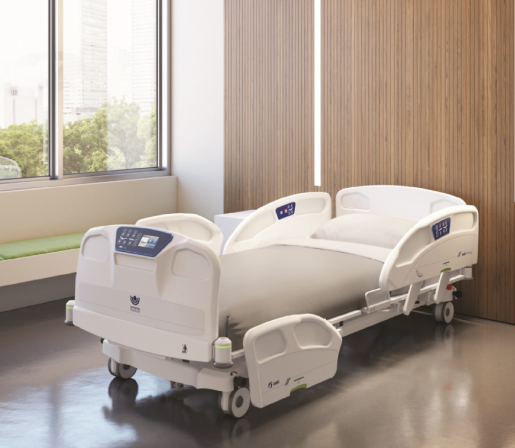
The benefits of bariatric hospital beds
By
Published on July 31, 2024
What are the advantages of a bariatric hospital bed?
Bariatric hospital beds represent a critical component in contemporary healthcare, particularly as global obesity rates continue to rise. Recent research has shown that almost one third of patients admitted to US hospitals alone were obese.
Obesity significantly impacts healthcare costs across all categories of a healthcare facility’s expenditures. It also presents numerous clinical and logistical challenges in hospital settings.
Patients weighing more than 300 pounds are often referred to as "patients of size" and require specialized equipment and staffing. The physical size of these patients necessitates extra-wide hospital beds, for example to enhance their care management and treatment.
However, studies show that one impediment to bariatric care was a lack of equipment, with only 11.4% of hospitals owning all the required equipment.
If we continue with the example of hospital beds, standard medical beds are not designed to accommodate the size and weight of bariatric patients. And the ripple effect of not using the right medical equipment for bariatric patients is substantial. A patient of size placed on a bed of insufficient size or weight capacity may experience negative outcomes, including:
- Increased risk of pressure injuries
- Decline in functional independence due to difficulty in repositioning
- Sleep deprivation due to discomfort
- Increased risk of injury to caregivers when attempting to turn or reposition a patient
Without specially designed bariatric hospital beds, patients are more susceptible to falls during transfers and musculoskeletal injuries.
As obesity becomes increasingly prevalent, affecting millions worldwide, the demand for healthcare solutions, including heavy-duty hospital beds, that can accommodate the unique needs of obese patients is escalating.
Let’s explore the many benefits of bariatric hospital beds for patients, staff and hospitals.
Heavy-duty beds: Enhanced patient safety and care experience
Bariatric hospital beds offer a range of features specifically designed to improve the patient experience:
Adjustable bed height
Some bariatric hospital beds feature height adjustment settings, which significantly facilitates easier patient mobility.
By minimizing the bed height, patients can independently and comfortably maneuver with reduced assistance, promoting a greater sense of independence and confidence.
If patients perform more activities independently, such as sitting up, getting in and out of bed, and adjusting their position, the need for constant assistance from healthcare staff is minimized. This can lead to more efficient use of hospital resources and allows caregivers to focus on other critical tasks.
Fall risk management
Bariatric hospital beds with advanced bed exit technologies and ergonomic siderail designs are instrumental in preventing injuries related to falls.
For instance, integrated bed-exit alarms alert staff when a patient attempts to leave the bed unassisted, substantially reducing the risk of falls.
Adjustable height settings and tilting functions allow patients to easily transition from lying down to sitting up, fostering independence while minimizing the need for physical assistance from caregivers.
The sophisticated siderails provide not only support for maneuvering extra-wide hospital beds but also ensure that adjustments to the patient’s position are smooth and safe.
Smart night lights
To maximize patient safety further, several new types of heavy-duty hospital beds are equipped with smart night lights as part of overall patient room lighting.
These lights provide patients with a clear view of their surroundings during nighttime hours, helping to prevent patients from getting up in the dark, minimizing disorientation and allowing for safer movements.
This feature is especially important in maintaining a secure environment, giving bariatric patients the confidence to move independently when necessary.
Extra-wide hospital beds: Increased patient comfort
Wider dimensions
The wider dimensions of the bariatric hospital beds represent another clear benefit as they surpass the width of standard hospital beds.
This extra space allows patients to move around more freely, significantly elevating their comfort and autonomy within the bed.
Some models of extra wide hospital beds incorporate innovative Infinite™ width technologies and integrated bed extenders, allowing healthcare staff to quickly adapt the bed to accommodate any patient size. This versatility eliminates the need for switching to specialty beds specifically for bariatric patients, streamlining the caregiving process.
Bariatric hospital beds: Other uses
Did you know that bariatric hospital beds can have a dual function? An extensively certified extra-wide hospital bed can be used by by two people, facilitating much-needed proximity between patients and their loved ones during long stays or for hospice care.
This means that healthcare facilities with both bariatric and palliative units can maximize their investments with heavy-duty hospital beds.
However, keep in mind that not all extra-wide hospital beds are certified to accommodate two people. This versatile hospital bed is, however.
Adjustable positions
Bariatric hospital beds are equipped with multiple adjustable positions, ensuring that each patient's comfort level is optimally met throughout their stay. This adaptability provides personalized comfort that can be tailored to the specific needs and preferences of each patient.
One model of an extra wide hospital bed features a BoostlessTM backrest system. This game-changing system is designed to reduce patient sliding, which reduces skin friction and shearing, which can lead to pressure injuries, and the need for frequent repositioning.
By moving the backrest section backward while the bed is elevating, the system ensures that patients remain comfortably in place.
Improved staff efficiency with heavy-duty hospital beds
Bariatric hospital beds not only enhance the patient experience but also contribute to staff efficiency and well-being by streamlining their day-to-day tasks.
In a 2021 study among healthcare professionals 75% indicated that the number-one barrier to the provision of bariatric care within their clinical areas was a lack of equipment.
Evidently, bariatric hospital beds can ease pressure on staff.
Maximum maneuverability
Maximum maneuverability is a crucial benefit of the latest heavy-duty hospital beds on the market, easing how caregivers can reposition and transport patients within healthcare facilities. In turn, better maneuverability means healthcare teams can focus on providing care rather than struggle with cumbersome equipment.
Efficient maneuverability boost operational effectiveness—but also contributes to workplace health and safety and less absenteeism.
Bariatric hospital beds minimizing physical strain with electronic control, which diminishes the need for staff to perform manual lifts or exert excessive force. This significantly lowers the risk of back injuries and other musculoskeletal disorders that are commonly associated with the manual handling of patients.
Some bariatric hospital beds have also been developed to simplify patient transfers. Equipped with a centralized 5th wheel, these medical beds offer smooth steering and the ability to perform sharp 360˚ turns effortlessly.
This feature greatly simplifies the task of moving the bed through tight corridors and crowded hospital wards.
Smart bariatric hospital beds
Smart bariatric hospital beds can now integrate advanced monitoring and data into the caregiving process. Care teams can visualize and
monitor bed status events and in-bed patient movements in real-time. This allows for targeted interventions only when necessary, saving valuable staff time and optimizing patient care.
Nurse managers gain a valuable oversight tool through the easy-to-understand dashboardd. They can monitor bed groups with ease, assess adherence to fall prevention protocols across care units, and take proactive steps to reinforce safety measures.
Taking hospital efficiency and care to a whole new level
Beyond the direct benefits for patients and staff, choosing the right bariatric bed for your hospital can maximize versatility.
Increased weight capacity
Bariatric beds are specifically designed to hold the weight of larger patients, addressing the crucial need for durability and stability in medical care environments.
Heavy-duty hospital beds can feature a weight capacity ranging from 70 to 1060 pounds, making them highly adaptable for any patient size. This broad range not only ensures that the beds can accommodate various patient needs but also increases the beds' utility in diverse medical environments.
Durability of heavy-duty hospital beds
Durability is another main advantage of high-quality bariatric hospital beds. These beds are designed with robust materials and solid construction to endure the daily rigors of healthcare environments.
The ability to withstand frequent use and maintain structural integrity under considerable weight is crucial, which ensures that the bed remains safe and functional for years.
A durable bariatric bed prevents equipment failure and offers substantial cost savings over time by minimizing the need for frequent replacements and maintenance.
For healthcare facilities, investing in durable bariatric hospital beds translates into a notable return on investment.
Choosing the perfect bariatric hospital bed: Other considerations
Choosing the right bariatric hospital bed should be based on criteria that meets the needs of your care unit patients and facilitate daily operations.
Don’t forget to look into the support surfaces that potential vendors offer. They can also make a world of difference for bariatric patients.
For an in-depth look at what to consider before making your selection, be sure to learn about the seven factors to consider when choosing a support surface for patients.
Interested in learning more about bariatric hospital beds?
About the author
Related articles

Headquarters
230 Nilus-Leclerc Blvd.
L'Islet, QC G0R 2C0
CANADA
1 844 409-4030
Lévis Office
470 3e Avenue
Lévis, QC G6W 5M6
CANADA
US Location
11845 Adie Rd.
Maryland Heights, MO 63043
UNITED STATES
Sherbrooke Office
670, Joseph-Louis-Mathieu Rd.
Sherbrooke, J1R 0X3
CANADA
Careers
Our talented and passionate team is determined to revolutionize the medical industry. Be part of the journey: join the Umano Experience.
See available jobsConnect with us
Copyright © 2025 Umano Medical inc







